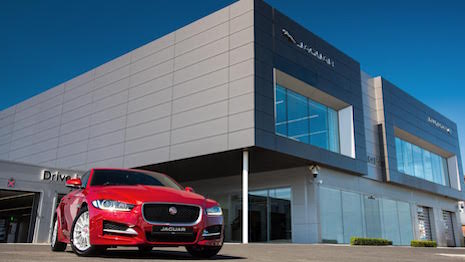- About
- Subscribe Now
- New York,
September 26, 2017

 Jaguar XE outside a dealership
Jaguar XE outside a dealership
While many innovators in the automotive space are looking to make auto shopping a more simplified process, consumers are spending even more time researching before purchasing.
A new white paper from Adtaxi reveals that in 2005, vehicle shoppers went to an average of about five dealerships when they decided to purchase a car. Ten years later, in 2015, consumers were only visiting one to two, while overall research time increased.
“The biggest challenges dealerships experience is keeping up in a multi-device world and understanding what’s working and what’s not,” said Brian Kroll, vice president of sales and strategic accounts at Adtaxi. “To do this well, you must understand the inner-workings of digital media buys and how to leverage insights from attribution reports.
“Technology is changing fast, and the required skills needed to analyze campaigns and move budgets between various platforms wasn’t taught to those with traditional media backgrounds,” he said.
Dealerships and digital
With so many digital channels and platforms that bring an increased amount of information to consumers’ fingertips, the discovery and research portion of the customer journey when buying a car has been taken off site. Consumers are more likely to research at home rather than visit multiple dealerships.
Ferrari dealership
2016 saw a significant year for new car sales, making it the seventh year in a row the industry broke sales records. However, 2017 will likely not be as fruitful.
Many dealerships are finding issues from their marketing efforts not being cohesive. There is no seamless experience or sharing of data between the various platforms used to advertise on, creating a fragmented and confusing message to consumers.
Dealerships need to think in terms of geographical points and factor in location targeting with their digital marketing. Consumers are likely not going to drive past one dealership to reach another that is a half hour away to get an oil change, so dealerships need to think about these factors and incorporate them into their marketing.
Innovative methods of buying cars are becoming more prevalent such as this auto vending machine
With so many targeting options available through digital marketing, dealers and auto marketers are doing themselves a disservice by not taking advantage.
Additional insight
Automotive dealerships that provide their customers with more digital, and specifically mobile, tools for scheduling and receiving service do far better with younger consumers than those that do not, according to a new study.
This information comes from J.D. Power’s 2017 United Kingdom Customer Service Index Study, which compared the performance of various car dealerships with different age groups based on the level of digital integration. What the study found was that loyalty to a dealership correlates with customer satisfaction, which in turn overwhelmingly correlates with a dealer’s ability to provide service through digital and mobile tools (see more).
Luxury automotive manufacturers have the ability to increase returning loyal customers by implementing a form of text message updates when servicing vehicles.
A new report from J.D. Power shows that 55 percent of consumers said they would definitely return when contacted through phone calls from personnel regarding service on their vehicles. However that percentage increases to 67 when customers are able to receive text updates on their vehicle service (see more).
“Everyone feels good about conquesting business from the same-brand competitor on the other side of town, but is that customer going to drive 30 minutes back past those same competitors for a $40 oil change or to fix an open recall,” said Joel Sesco, national director of automotive at Adtaxi. “Pumping a unit into a competitor’s backyard still counts as a sale, but with the increased need to directly compete on price and a low likelihood of transitioning that customer to a dealer’s fixed operations profit centers, the return on those marketing dollars spent to generate that sale may not add up.”
Share your thoughts. Click here